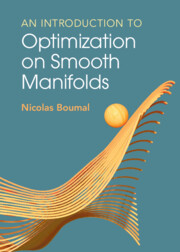Book contents
- Frontmatter
- Dedication
- Contents
- Preface
- Notation
- 1 Introduction
- 2 Simple examples
- 3 Embedded geometry: first order
- 4 First-order optimization algorithms
- 5 Embedded geometry: second order
- 6 Second-order optimization algorithms
- 7 Embedded submanifolds: examples
- 8 General manifolds
- 9 Quotient manifolds
- 10 Additional tools
- 11 Geodesic convexity
- References
- Index
9 - Quotient manifolds
Published online by Cambridge University Press: 09 March 2023
- Frontmatter
- Dedication
- Contents
- Preface
- Notation
- 1 Introduction
- 2 Simple examples
- 3 Embedded geometry: first order
- 4 First-order optimization algorithms
- 5 Embedded geometry: second order
- 6 Second-order optimization algorithms
- 7 Embedded submanifolds: examples
- 8 General manifolds
- 9 Quotient manifolds
- 10 Additional tools
- 11 Geodesic convexity
- References
- Index
Summary
Optimization problems often have symmetries. For example, the value of the cost function may not change if its input vectors are scaled, translated or rotated. Then, it makes sense to quotient out the symmetries. If the quotient space is a manifold, it is called a quotient manifold. This often happens when the symmetries result from invariance to group actions: This chapter first reviews conditions for this to happen. Continuing with general quotient manifolds, the chapter reviews geometric concepts (points, tangent vectors, vector fields, retractions, Riemannian metrics, gradients, connections, Hessians and acceleration) to show how to work numerically with these abstract objects through lifts. The chapter aims to show the reader what it means to optimize on a quotient manifold, and how to do so on a computer. To this end, two important sections detail the relation between running Riemannian gradient descent and Newton’s method on the quotient manifold compared to running them on the non-quotiented manifold (called the total space). The running example is the Grassmann manifold as a quotient of the Stiefel manifold. Its tools are summarized in a closing section.
Information
- Type
- Chapter
- Information
- An Introduction to Optimization on Smooth Manifolds , pp. 205 - 251Publisher: Cambridge University PressPrint publication year: 2023
